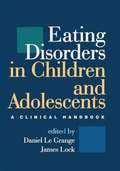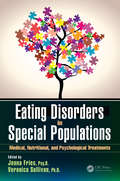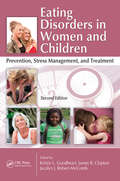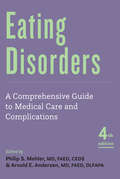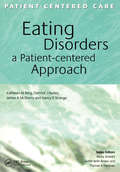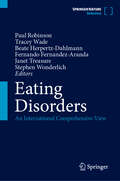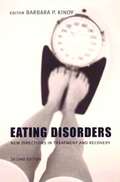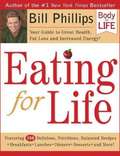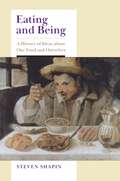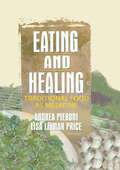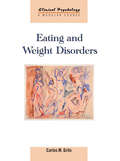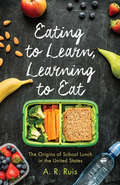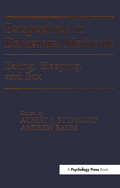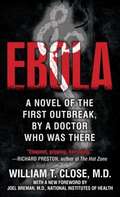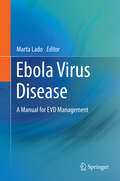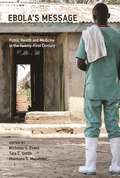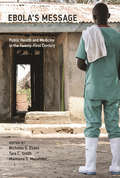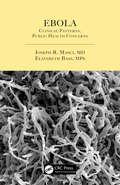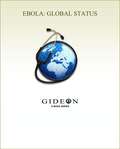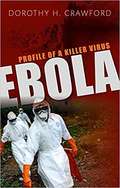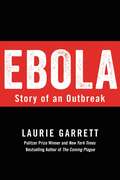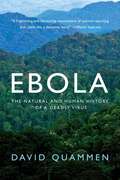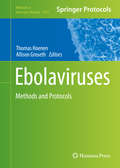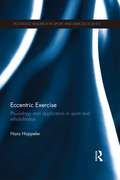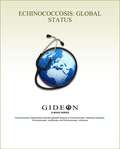- Table View
- List View
Eating Disorders in Children and Adolescents
by Daniel Le Grange James LockBringing together leading authorities, this comprehensive volume integrates the best current knowledge and treatment approaches for eating disorders in children and adolescents. The book reveals how anorexia nervosa, bulimia nervosa, and other disorders present differently developmentally and explains their potentially far-reaching impact on psychological, physical, and neurobiological development. It provides guidelines for developmentally sound assessment and diagnosis, with attention to assessment challenges unique to this population. Detailed descriptions of evidence-based therapies are illustrated with vivid case examples. Promising directions in prevention are also addressed. A special chapter offers a parent's perspective on family treatment.
Eating Disorders in Special Populations: Medical, Nutritional, and Psychological Treatments
by Jonna Fries Veronica SullivanEating disorders are among the most complex disorders to treat, typically requiring medical, nutritional, and psychotherapeutic interventions. High relapse rates and the sense of urgency to save lives and minimize or prevent lifelong problems present challenges for even the most seasoned treatment providers.In an engaging, clear, and concise manner, Eating Disorders in Special Populations: Medical, Nutritional, and Psychological Treatments prepares physicians, dietitians, and psychotherapists to navigate the labyrinth they enter with eating disordered patients. Aggregating a vast amount of information and perspectives in a clear and concise format, readers will gain insight into the minds on both sides of the treatment room.From leading experts in the field, readers will learn how dietitians, physicians, and psychotherapists conceptualize and treat people with eating disorders, and treatment providers will discover the nuanced etiologies of eating disorder symptoms in a range of diverse populations. Increase your cultural competency and expand your practice by learning how eating disorders are created, maintained, and resolved. Join us in bringing light, health, and hope to our patients and to our colleagues across disciplines.
Eating Disorders in Women and Children: Prevention, Stress Management, and Treatment, Second Edition
by Ljubisa R. RadovicOur understanding of eating disorders has improved markedly over the past 10 years since the publication of the previous edition of this volume. Early intervention is the key, as body dissatisfaction, obsession with thinness, and restrained and binge eating can be found in those as young as ten. Exploring prevention methods and therapeutic options, the second edition of Eating Disorders in Women and Children: Prevention, Stress Management, and Treatment is updated with new research on these devastating maladies.Highlights in the second edition include: An emphasis on the physiology of eating disorders and genetic factors related to anorexia and bulimia Theories on prevention and the identification of at-risk individuals The latest information on therapeutic modalities, including cognitive behavioral, interpersonal, constructionist, and narrative approaches as well as pharmaceutical management Nutritional evaluation and treatment Specific exercise recommendations for women and children with eating disorders An accompanying downloadable resources containing a PowerPoint® presentation for each chapter With contributions from acclaimed clinicians widely known for their work with the eating disorder population, this volume recognizes the multifaceted nature of these disorders, addresses the widening demographic range of those afflicted, and delves into the issues behind their development. It provides practical recommendations for treatment from many perspectives, presenting enormous hope for people who painfully struggle with these disorders. In addition, it explores critical measures that can be taken to help the larger population understand and work to prevent eating disorders in their communities.
Eating Disorders: A Comprehensive Guide to Medical Care and Complications
by Philip S. Mehler, MD, FAED, CEDS and Arnold E. Andersen, MD, FAED, DLFAPAA comprehensive guide on how to diagnose, treat, and care for those with eating disorders.Eating disorders, which include such conditions as anorexia, bulimia, binge eating, and pica, represent a challenge to both patients and health care providers alike. For more than 20 years, health care providers have turned to the expert advice found in Eating Disorders to keep up to date with the latest research in the field and to help them provide the best care available for their patients. In this new, thoroughly revised and expanded edition of their best-selling work, Drs. Philip S. Mehler and Arnold E. Andersen provide a user-friendly and comprehensive guide to treating and managing eating disorders for primary care physicians, mental health professionals, worried family members and friends, and nonmedical professionals (such as teachers and coaches). Mehler and Andersen • identify common medical complications faced by people who have eating disorders• answer questions about how to treat both physical and behavioral aspects of eating disorders• discuss serious complications, including cardiac arrhythmia, electrolyte abnormalities, and gastrointestinal problems• incorporate all-new information on avoidant restrictive food intake disorder (ARFID), binge eating disorder, and the role of social media in promoting disordered eating• offer targeted advice for working with specialists• include four new chapters on eating disorders in children and adolescents; atypical anorexia; eating disorders in transgender individuals; and family therapy• feature engaging clinical vignettes • answer a list of common questions practitioners may have in each chapterThe most comprehensive work on the market and the only book that covers eating disorders in transgender individuals, Eating Disorders is a compassionate, evidence-based, and essential guide.Contributors: Arnold E. Andersen, Ovidio Bermudez, Jeana Cost, Meghan Foley, Dennis Gibson, Neville Golden, Sacha Gorell, Jeffrey Hollis, Mori J. Krantz, Daniel Le Grange, Russell Marx, Jennifer McBride, Philip S. Mehler, Leah Puckett, Katherine Sachs, Michael Spaulding-Barclay, Anna Tanner, Nathalia Trees, Jessica Tse, Kenneth Weiner, Patricia Westmoreland
Eating Disorders: A Patient-Centered Approach
by Kathleen M Berg J Hurley Dermot James A McSherry Nancy E StrangeProviding a wide range of questions for all doctors wishing to take the Professional and Linguistics Board Test required for foreign nationals who want to practice in the UK, this title is a comprehensive primer for the examination. Presented in a workbook style, with spaces for the answers to be entered, it provides a wide range of questions examining over 1250 extended matching questions. It also includes contact details for key UK medical organizations and institutions and guidance to PLAB candidates from the General Medical Council.
Eating Disorders: An International Comprehensive View
by Paul Robinson Janet Treasure Tracey Wade Beate Herpertz-Dahlmann Stephen Wonderlich Fernando Fernandez-ArandaThis Handbook covers all eating disorders in every part of the world. Eating disorders in Western countries are described but also in different parts of Asia, Africa, the Middle East, amongst indigenous peoples, and peoples of cultural and linguistic diversity, Latin America and Eastern Europe and we will describe the impact of pandemics. The sections are organised with an introduction followed by definitions and classifications, then epidemiology, then psychosocial aetiology, clinical features, neurobiology, family peers and carers, and finally conclusions. The latest DSM and ICD classifications are covered and eating disorders not yet classified. The authors cover the clinical features of eating disorders complicating diabetes type 1, the neurobiology of eating disorders including immunology, neurotransmitters and appetite. The treatment section will include emergency treatment, evidence-based psychological approaches, intensive interventions and emerging areas, and the family section will include voluntary bodies, family and carers and pregnant mothers with eating disorders. Outcome covers prognosis in all the major eating disorders and describe the severe and enduring type of eating disorder. The work is the primary source of information about eating disorders for students, doctors, psychologists and other professionals. The fact that it is regularly updated makes it second only to primary sources such as journals for retrieving information on the subject. In contrast to journals the manual will provide accessibility unavailable elsewhere.
Eating Disorders: New Directions in Treatment and Recovery (Issues Ser. #Vol. 127)
by Ed. Kinoy Barbara P.Fully revised to reflect changes in the field, this collection of essays by psychotherapists who specialize in the treatment of anorexia nervosa and bulimia explains in accessible and humane terms how the treatment process works and demonstrates strategies that lead to recovery. The book details the interaction between practitioner and patient, practitioner and practitioner, and family members. The collection, which draws upon the knowledge and experience of clinicians who have practiced at the Wilkins Center for Eating Disorders, also points up the advantages of a collaborative team, for both the patient and professionals.
Eating For Life: Your Guide to Great Health, Fat Loss and Increased Energy!
by Bill Phillips"There are two keys to eating right: First, you have to know what to do, and second, you must do what you know!" explains Bill Phillips, author of the #1 New York Times bestseller Body-For-LIFE. That's what this book is all about: first discovering how to nourish your body the right way and then learning to apply this information, so you can enjoy greater health, reduce body-fat and gain energy! Bill Phillips' Eating for Life is not about dieting. It's about feeding your body, not starving it. It's a celebration of the abundant variety of nutritious, delicious foods that support your health, while satisfying your appetite. It's a safe and sound lifestyle based on the most up-to-date scientific findings. And, it's a practical, commonsense approach which takes the guesswork out of eating right, once and for all.
Eating and Being: A History of Ideas about Our Food and Ourselves
by Steven ShapinWhat we eat, who we are, and the relationship between the two. Eating and Being is a history of Western thinking about food, eating, knowledge, and ourselves. In modern thought, eating is about what is good for you, not about what is good. Eating is about health, not about virtue. Yet this has not always been the case. For a great span of the past—from antiquity through about the middle of the eighteenth century—one of the most pervasive branches of medicine was known as dietetics, prescribing not only what people should eat but also how they should order many aspects of their lives, including sleep, exercise, and emotional management. Dietetics did not distinguish between the medical and the moral, nor did it acknowledge the difference between what was good for you and what was good. Dietetics counseled moderation in all things, where moderation was counted as a virtue as well as the way to health. But during the nineteenth century, nutrition science began to replace the language of traditional dietetics with the vocabulary of proteins, fats, carbohydrates, and calories, and the medical and the moral went their separate ways. Steven Shapin shows how much depended upon that shift, and he also explores the extent to which the sensibilities of dietetics have been lost. Throughout this rich history, he evokes what it felt like to eat during another historical period and invites us to reflect on what it means to feel about food as we now do. Shapin shows how the change from dietetics to nutrition science fundamentally altered how we think about our food and its powers, our bodies, and our minds.
Eating and Healing: Traditional Food As Medicine
by Andrea Pieroni Lisa PriceDiscover neglected wild food sourcesthat can also be used as medicine!The long-standing notion of food as medicine, medicine as food, can be traced back to Hippocrates. Eating and Healing: Traditional Food As Medicine is a global overview of wild and semi-domesticated foods and their use as medicine in traditional s
Eating and Weight Disorders: A Modular Course: Eating And Weight Disorders (Clinical Psychology: A Modular Course)
by Carlos M. GriloEating disorders refer to a range of problems characterized by abnormal eating behaviours and beliefs about eating, weight, and shape. Eating disorders, which are classified as psychiatric problems, and obesity, which is classified as a general medical condition, reflect a diverse and perplexing array of biological, social, and psychological phenomena. Beginning with a comprehensive overview of eating and weight disorders, this volume also covers: anorexia nervosa bulimia nervosa atypical eating disorders and binge eating disorders obesity. Including the most up-to-date research, Carlos Grilo provides a balanced and authoritative overview of current thinking in the fields of eating disorders and obesity with broad yet in-depth coverage of the areas. This highly readable book is an indispensable resource to students and professionals in clinical psychology, health psychology, and psychiatry.
Eating to Learn, Learning to Eat: The Origins of School Lunch in the United States
by Andrew R. RuisIn Eating to Learn, Learning to Eat, historian A. R. Ruis explores the origins of American school meal initiatives to explain why it was (and, to some extent, has continued to be) so difficult to establish meal programs that satisfy the often competing interests of children, parents, schools, health authorities, politicians, and the food industry. Through careful studies of several key contexts and detailed analysis of the policies and politics that governed the creation of school meal programs, Ruis demonstrates how the early history of school meal program development helps us understand contemporary debates over changes to school lunch policies.
Eating, Sleeping, and Sex: Perspectives in Behavioral Medicine (Perspectives on Behavioral Medicine Series)
by Albert J. Stunkard; Andrew BaumThe lack of balance and the failure of regulation in life has traditionally been recognized in such extreme symbolic acts as overconscientiousness or a criminal lack of conscience. This volume shows how the neurotic process affects biologic functions, distorting natural functioning. Three distinct functions and their respective extremes are discussed: eating (obesity, bulimia nervosa), sleeping (insomnia, excessive somnolence), and sex (hypersexuality including child molestation, hyposexuality including inhibited sexual desires).
Ebola
by William Close Joel Breman"Eloquent, gripping, harrowing."--Richard Preston, author of The Hot Zone When a mysterious virus first exploded in Zaire in 1976, American physician William T. Close worked desperately to contain the outbreak. Haunted by this wrenching crisis, Dr. Close felt compelled to honor the memory of the courageous people he knew and lost. This is their story: a terrifying, completely authentic novel that begins with an invisible killer. It strikes without warning--a lethal disease with no name . . . and no cure. At a Catholic mission in Yambuku, a remote village sixty miles south of the Ebola River, local teacher Mabalo Lokela visits the clinic with a raging fever. Sister Lucie, a Flemish nun and nurse, gives him a shot of an antimalarial drug, wipes off the syringe, and awaits her next patient. Within days, Mabalo is dead. Soon, others are falling ill. Less than three weeks later, the virus claims Sister Lucie's life as well. Panic erupts, but as the villagers attempt to flee, all roads leading out of Yambuku are closed off, the dying forced back. And as the single radio connecting the mission to the outside world brings only bad news, the valiant nuns and medical personnel left behind have no choice but to pray, and wonder: Will they survive long enough for help to arrive?
Ebola Virus Disease: A Manual For Evd Management
by Marta LadoThis current manual gives an overview to management of Ebola Virus Disease outbreaks from a practical point of view. It gives an introduction to the topic, reviews the history and previous outbreaks of Ebola virus disease and gives insight to clinical features of the disease. The major part of the book presents ways of response including screening, isolation and personal protection equipment as well as waste management during disease outbreaks. New therapies and experimental drugs are discussed in further detail. The last part of the volume deals with all aspects of diagnostics and practical laboratory handling of Ebola virus. <P><P> Dr. Marta Lado is the clinical lead of the King’s Sierra Leone Partnership in country team. She brings together a group of authors aggregating both well-grounded basic knowledge on Ebola virus as well as deep experience with Ebola Virus Disease in the field.
Ebola's Message: Public Health and Medicine in the Twenty-First Century
by Nicholas G. Evans Maimuna S. Majumder Tara C. SmithThe 2013--2015 outbreak of the Ebola virus disease (EVD) was a public health disaster: 28,575 infections and 11,313 deaths (as of October 2015), devastating the countries of Guinea, Liberia, and Sierra Leone; a slow and mismanaged international response; and sensationalistic media coverage, seized upon by politicians to justify wrongheaded policy. And yet there were also promising developments that may improve future responses to infectious disease epidemics: the UN Security Council's first involvement in a public health event; a series of promising clinical treatments and vaccines for EVD; and recognition of the need for a global public health system to deal with epidemics that cross national borders. This volume offers a range of perspectives on these and other lessons learned, with essays on the science, politics, and ethics of the Ebola outbreak.The contributors discuss topics including the virology and management of EVD in both rich and poor nations; the spread of the disease (with an essay by a leader of Médecins Sans Frontières); racist perceptions of West Africa; mainstream and social media responses to Ebola; and the ethical issue of whether to run clinical trials of experimental treatments during an outbreak. ContributorsChristian L. Althaus, Daniel G. Bausch, Adia Benton, Michael J. Connor, Jr., Kim Yi Dionne, Nicholas G. Evans, Morenike Oluwatoyin Folayan, Stephen Goldstein, Bridget Haire, Patricia C. Henwood, Kelly Hills, Cyril Ibe, Marjorie Kruvand, Lisa M. Lee, Maimuna S. Majumder, Alexandra L. Phelan, Annette Rid, Cristine Russell, Lara Schwarz, Laura Seay, Michael Selgelid, Tara C. Smith, Armand Sprecher
Ebola's Message: Public Health and Medicine in the Twenty-First Century (Basic Bioethics)
by Nicholas G. Evans Maimuna S. Majumder Tara C. SmithInterdisciplinary perspectives on the science, politics, and ethics of the 2013–2015 Ebola virus disease outbreak.The 2013–2015 outbreak of the Ebola virus disease (EVD) was a public health disaster: 28,575 infections and 11,313 deaths (as of October 2015), devastating the countries of Guinea, Liberia, and Sierra Leone; a slow and mismanaged international response; and sensationalistic media coverage, seized upon by politicians to justify wrongheaded policy. And yet there were also promising developments that may improve future responses to infectious disease epidemics: the UN Security Council's first involvement in a public health event; a series of promising clinical treatments and vaccines for EVD; and recognition of the need for a global public health system to deal with epidemics that cross national borders. This volume offers a range of perspectives on these and other lessons learned, with essays on the science, politics, and ethics of the Ebola outbreak. The contributors discuss topics including the virology and management of EVD in both rich and poor nations; the spread of the disease (with an essay by a leader of Médecins Sans Frontières); racist perceptions of West Africa; mainstream and social media responses to Ebola; and the ethical issue of whether to run clinical trials of experimental treatments during an outbreak. Contributors Christian L. Althaus, Daniel G. Bausch, Adia Benton, Michael J. Connor, Jr., Kim Yi Dionne, Nicholas G. Evans, Morenike Oluwatoyin Folayan, Stephen Goldstein, Bridget Haire, Patricia C. Henwood, Kelly Hills, Cyril Ibe, Marjorie Kruvand, Lisa M. Lee, Maimuna S. Majumder, Alexandra L. Phelan, Annette Rid, Cristine Russell, Lara Schwarz, Laura Seay, Michael Selgelid, Tara C. Smith, Armand Sprecher
Ebola: Clinical Patterns, Public Health Concerns
by Elizabeth Bass Joseph R. MasciEbola: Clinical Patterns, Public Health Concerns is a concise description and discussion of the Ebola virus and disease. The intended audience is medical practitioners, including those working in endemic areas as well as health-facility planners and public health practitioners. The book fills an important gap between large texts covering not only Ebola but other hemorrhagic fever viruses and brief pamphlet-style publications on the public health aspects of the infection. In light of the recent large outbreak in West Africa, this book is a part of the developing foundation needed to deal with emerging diseases.
Ebola: Global Status 2010 edition
by Dr Stephen Berger Gideon InformaticsEbola: Global Status is one in a series of GIDEON ebooks which summarize the status of individual infectious diseases, in every country of the world. Data are based on the GIDEON database (www.gideononline.com) which relies on standard text books, peer-review journals, Health Ministry reports and ProMED, supplemented by an ongoing search of the medical literature. Chapters are arranged alphabetically, by country name. Each section is divided into six subsections. 1. Descriptive epidemiology 2. Summary of clinical features 3. Global status of the disease4. Potential use in Bioterrorism 5. Status of the disease in a specific country 6. References
Ebola: Profile of a Killer Virus
by Dorothy H. CrawfordFirst discovered in 1976, and long regarded as an easily manageable virus affecting isolated rural communities, Ebola rocketed to world prominence in 2014 as a deadly epidemic swept through Guinea, Sierra Leone, and Liberia in West Africa. Thousands of people died as the extraordinarily contagious disease spread rapidly from villages to urban centres. Initial quarantine responses proved often too little and too late, and the medical infrastructure of the affected countries struggled to cope. <p><p> By August 2014, several months after the start of the outbreak, the WHO declared the epidemic a public health emergency and international aid teams and volunteers began to pour in. But halting the epidemic proved to be hugely challenging, not only in terms of the practicalities of dealing with the sheer numbers of patients carrying the highly infectious virus, but in dealing with social and cultural barriers. <p><p> The author, Dorothy Crawford, visited Sierra Leone while the epidemic was ongoing and met with those on the frontline in the fight against the virus. In Ebola Crawford combines personal accounts from these brave medical workers with the latest scientific reports to tell the story of the epidemic as it unfolded, and how it has changed our understanding of the virus. She looks at its origin and spread, the international response, and its devastating legacy to the health of those living in the three worst affected countries. She describes the efforts to prevent international spread, the treatment options for Ebola, including the drug and vaccine trials that eventually got underway in 2015, and the sensitive issue of running trials of experimental therapies during a lethal epidemic.
Ebola: Story of an Outbreak
by Laurie GarrettWhere does Ebola originate? How does it spread? And what should governments do to stop it? Few people understand the answers to these questions better than Pulitzer Prize-winning journalist Laurie Garrett. In this masterful account of the 1995 Ebola outbreak in Zaire, Garrett, now the Senior Fellow for Global Health at the Council on Foreign Relations, shows how superstition and fear, compounded by a lack of resources, education, and clearheaded government planning have plagued our response to Ebola. In an extensive new introduction, Garrett forcefully argues that learning from past outbreaks is the key to solving the Ebola crisis of 2014.In her account of the 1995 Zaire outbreak, first published in her bestselling book Betrayal of Trust, Garrett takes readers through the epidemic's course-beginning with the Kikwit villager who first contracted it from an animal encounter while chopping wood for charcoal deep in the forest. As she documents the outbreak in riveting detail, Garrett shows why our trust in world governments to protect people's health has been irrevocably broken. She details the international community's engagement in the epidemic's aftermath: a pattern of response and abandonment, urgency that devolves into amnesia. EBOLA: STORY OF AN OUTBREAK is essential reading for anyone who wants to comprehend Ebola, one of mankind's most mysterious, malicious scourges. Garrett has issued a powerful call for governments, citizens, and the disease-fighting agencies of the wealthy world to take action.
Ebola: The Natural and Human History of a Deadly Virus
by David QuammenIn 1976 a deadly virus emerged from the Congo forest. As swiftly as it came, it disappeared, leaving no trace. Over the four decades since, Ebola has emerged sporadically, each time to devastating effect. It can kill up to 90 percent of its victims. In between these outbreaks, it is untraceable, hiding deep in the jungle. The search is on to find Ebola's elusive host animal. And until we find it, Ebola will continue to strike. Acclaimed science writer and explorer David Quammen first came near the virus while he was traveling in the jungles of Gabon, accompanied by local men whose village had been devastated by a recent outbreak. Here he tells the story of Ebola--its past, present, and its unknowable future. Extracted from Spillover by David Quammen, updated and with additional material.
Ebolaviruses
by Thomas Hoenen Allison GrosethThis vital book collects key methods that have supported advancements in the field of ebolavirus molecular biology given the pressing need for the advancement of techniques for diagnostics, the development of vaccines and antivirals, and for furthering our understanding of ebolavirus biology. After an introduction, the volume delves into protocols for studying ebolavirus molecular biology under biosafety level 2 conditions, studying infectious ebolaviruses under biosafety level 4 conditions in vitro as well as in vivo, and working with ebolaviruses in the field. Written for the highly successful Methods in Molecular Biology series, chapters include introductions to their respective topics, lists of the necessary materials and reagents, step-by-step, readily reproducible laboratory protocols, and tips on troubleshooting and avoiding known pitfalls. Authoritative and practical, Ebolaviruses: Methods and Protocols serves as a guide to the next generations of filovirus researchers and also helps to bring experts from other areas into the filovirus research arena.
Eccentric Exercise: Physiology and application in sport and rehabilitation (Routledge Research in Sport and Exercise Science)
by Hans HoppelerEccentric muscle contraction, during which a muscle lengthens while under tension, is a fundamental process of human movement but a surprisingly under-researched area of exercise science. Evidence suggests that training programmes which incorporate both eccentric and concentric contractions can result in greater strength gains than concentric contractions alone, and this clearly has important implications for training and rehabilitation in sport and health. In Eccentric Exercise, leading international sport scientist Hans Hoppeler introduces the fundamental physiology and pathophysiology of eccentric muscle work, and explores the key applications of eccentric exercise in sport, rehabilitation and health. The book examines the molecular mechanisms responsible for tissue and organismic adaptations and discusses eccentric muscle-related pathology, specifically delayed onset muscle soreness. It assesses the use of eccentric exercise training in the treatment of certain disease states such as chronic obstructive pulmonary disease, heart insufficiency and sarcopenia, while a concluding chapter points to open research questions, shows the limits of the available data and highlights problems with current exercise modalities. This book is important reading for all sport and exercise scientists, clinicians working in rehabilitation, and high-level strength and conditioning coaches and trainers.
Echinococcosis: Global Status 2010 edition
by Dr Stephen Berger Gideon InformaticsEchinococcosis: Global Status is one in a series of GIDEON ebooks which summarize the status of individual infectious diseases, in every country of the world. Data are based on the GIDEON database (www.gideononline.com) which relies on standard text books, peer-review journals, Health Ministry reports and ProMED, supplemented by an ongoing search of the medical literature. Chapters are arranged alphabetically, by country name. Each section is divided into five subsections. 1. Descriptive epidemiology 2. Summary of clinical features 3. Global status of the disease 4. Status of the disease in a specific country 5. References Echinococcosis: Global Status includes separate sections on Echinococcosis - American polycystic, Echinococcosis - multilocular, and Echinococcosis - unilocular.
